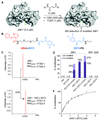A Specific and Covalent JNK-1 Ligand Selected from an Encoded Self-Assembling Chemical Library
- PMID: 28485044
- PMCID: PMC5557334
- DOI: 10.1002/chem.201701644
A Specific and Covalent JNK-1 Ligand Selected from an Encoded Self-Assembling Chemical Library
Abstract
We describe the construction of a DNA-encoded chemical library comprising 148 135 members, generated through the self-assembly of two sub-libraries, containing 265 and 559 members, respectively. The library was designed to contain building blocks potentially capable of forming covalent interactions with target proteins. Selections performed with JNK1, a kinase containing a conserved cysteine residue close to the ATP binding site, revealed the preferential enrichment of a 2-phenoxynicotinic acid moiety (building block A82) and a 4-(3,4-difluorophenyl)-4-oxobut-2-enoic acid moiety (building block B272). When the two compounds were joined by a short PEG linker, the resulting bidentate binder (A82-L-B272) was able to covalently modify JNK1 in the presence of a large molar excess of glutathione (0.5 mm), used to simulate intracellular reducing conditions. By contrast, derivatives of the individual building blocks were not able to covalently modify JNK1 in the same experimental conditions. The A82-L-B272 ligand was selective over related kinases (BTK and GAK), which also contain targetable cysteine residues in the vicinity of the active site.
Keywords: DNA-encoded chemical libraries; covalent inhibitors; drug discovery; kinases; targetable cysteine.
© 2017 Wiley-VCH Verlag GmbH & Co. KGaA, Weinheim.
Figures



Similar articles
-
Inhibitor design against JNK1 through e-pharmacophore modeling docking and molecular dynamics simulations.J Recept Signal Transduct Res. 2016 Dec;36(6):558-571. doi: 10.3109/10799893.2016.1141955. Epub 2016 Feb 24. J Recept Signal Transduct Res. 2016. PMID: 26906522
-
Drug discovery with DNA-encoded chemical libraries.Bioconjug Chem. 2010 Sep 15;21(9):1571-80. doi: 10.1021/bc1001483. Bioconjug Chem. 2010. PMID: 20681509 Review.
-
ABPP-CoDEL: Activity-Based Proteome Profiling-Guided Discovery of Tyrosine-Targeting Covalent Inhibitors from DNA-Encoded Libraries.J Am Chem Soc. 2023 Nov 22;145(46):25283-25292. doi: 10.1021/jacs.3c08852. Epub 2023 Oct 19. J Am Chem Soc. 2023. PMID: 37857329
-
Discovery of a Covalent Kinase Inhibitor from a DNA-Encoded Small-Molecule Library × Protein Library Selection.J Am Chem Soc. 2017 Aug 2;139(30):10192-10195. doi: 10.1021/jacs.7b04880. Epub 2017 Jul 20. J Am Chem Soc. 2017. PMID: 28689404 Free PMC article.
-
20 years of DNA-encoded chemical libraries.Chem Commun (Camb). 2011 Dec 28;47(48):12747-53. doi: 10.1039/c1cc15634a. Epub 2011 Nov 14. Chem Commun (Camb). 2011. PMID: 22083211 Review.
Cited by
-
Recent Advances in Selective and Irreversible Covalent Ligand Development and Validation.Cell Chem Biol. 2019 Nov 21;26(11):1486-1500. doi: 10.1016/j.chembiol.2019.09.012. Epub 2019 Oct 17. Cell Chem Biol. 2019. PMID: 31631011 Free PMC article. Review.
-
Advances in covalent drug discovery.Nat Rev Drug Discov. 2022 Dec;21(12):881-898. doi: 10.1038/s41573-022-00542-z. Epub 2022 Aug 25. Nat Rev Drug Discov. 2022. PMID: 36008483 Free PMC article. Review.
-
Flexibility-tuning of dual-display DNA-encoded chemical libraries facilitates cyclic peptide ligand discovery.Nat Commun. 2025 Apr 5;16(1):3273. doi: 10.1038/s41467-025-58507-w. Nat Commun. 2025. PMID: 40188178 Free PMC article.
-
Identification of Structurally Novel KRASG12C Inhibitors through Covalent DNA-Encoded Library Screening.J Med Chem. 2025 Feb 27;68(4):4801-4817. doi: 10.1021/acs.jmedchem.4c03071. Epub 2025 Feb 11. J Med Chem. 2025. PMID: 39930787 Free PMC article.
-
Encoded Library Technologies as Integrated Lead Finding Platforms for Drug Discovery.Molecules. 2019 Apr 25;24(8):1629. doi: 10.3390/molecules24081629. Molecules. 2019. PMID: 31027189 Free PMC article. Review.
References
-
- Lerner RA, Brenner S. Angew Chem Int Ed. 2017;56:1664–1165. - PubMed
- Yuen LH, Franzini RM. Chembiochem. 2016 doi: 10.1002/cbic.201600567. - DOI - PubMed
- Zimmermann G, Neri D. Drug Discov Today. 2016;21:1828–1834. - PMC - PubMed
- Kleiner RE, Dumelin CE, Liu DR. Chem Soc Rev. 2011;40:5707–5717. - PMC - PubMed
- Shi B, Zhou Y, Huang Y, Zhang J, Li X. Bioorg Med Chem Lett. 2017;27:361–369. - PubMed
- Zambaldo C, Barluenga S, Winssinger N. Curr Opin Chem Biol. 2015;26:8–15. - PubMed
- None
- Blakskjaer P, Heitner T, Hansem NJV. Curr Opin Chem Biol. 2015;26:62–71. - PubMed
- Clark MA, Acharya RA, Arico–Muendel CC, Belyanskaya SL, Benjamin DR, Carlson NR, Centrella PA, Chiu CH, Creaser SP, Cuozzo JW, Davie CP, et al. Nat Chem Biol. 2009;5:647–654. - PubMed
- Petersen LK, Blakskjær P, Chaikuad A, Christensen AB, Dietvorst J, Holmkvist J, Knapp S, Kořínek M, Pedersen AE, Röhm S, Sløk FA, et al. Med Chem Commun. 2016;7:1332–1339.
-
- McCafferty J, Griffiths AD, Winter G, Chiswell DJ. Nature. 1990;348:552–554. - PubMed
- Kang AS, Barbas CF, Janda KD, Benkovic SJ, Lerner RA. Proc Natl Acad Sci USA. 2001;98:3750–3755. - PubMed
- Boder ET, Wittrup KD. Nature Biotechnol. 1997;15:553–557. - PubMed
- Wilson DS, Keefe AD, Szostak JW. Proc Natl Acad Sci USA. 2001;98:3750–3755. - PMC - PubMed
- Hansen J, Pluckthun A. Proc Natl Acad Sci USA. 1997;94:4937–4942. - PMC - PubMed
- Ellington AD, Szostak JW. Nature. 1990;346:818–822. - PubMed
- Tuerk C, Gold L. Science. 1990;249:505–510. - PubMed
-
- Wichert M, Krall N, Decurtins W, Franzini RM, Pretto F, Schneider P, Neri D, Scheuermann J. Nat Chem. 2015;7:241–249. - PubMed
-
- Melkko S, Zhang Y, Dumelin CE, Scheuermann J, Neri D. Angew Chem Int Ed. 2007;46:4671–4674. - PubMed
MeSH terms
Substances
Grants and funding
LinkOut - more resources
Full Text Sources
Other Literature Sources
Research Materials
Miscellaneous

